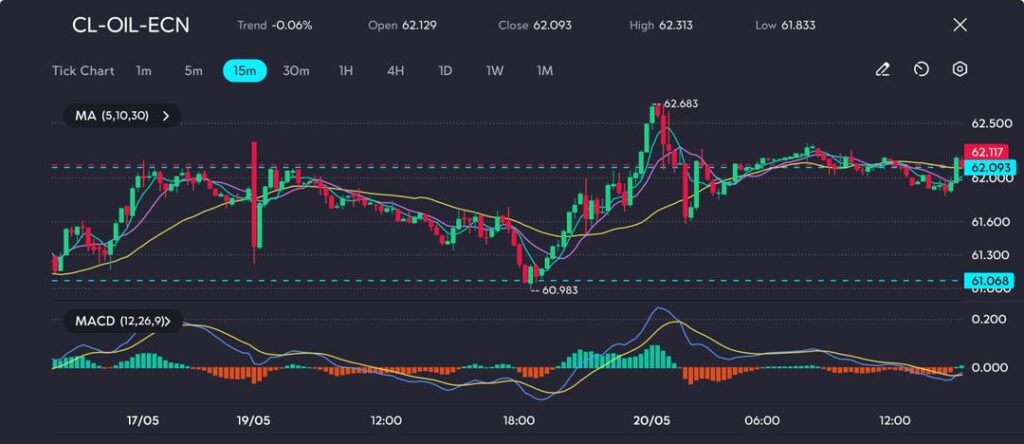
Key Points:
- WTI July futures dip to $61.97 as Brent holds above $65.
- Iran deal uncertainty limits supply outlook; peace talks could alter Russian flows.
- Asian refining margins strong, but China’s demand picture weakens.
Crude oil prices were little changed on Tuesday, with West Texas Intermediate (WTI) July contracts easing to $61.97 and Brent futures for July holding near $65.35. The market is caught in a tug-of-war between global negotiations, strong regional demand in Asia, and a murky economic outlook from China and the U.S.
One of the primary overhangs remains the uncertainty surrounding US-Iran nuclear negotiations. Tehran’s Deputy Foreign Minister stated that talks would stall if Washington demands a complete halt to enrichment, a key barrier to reviving the 2015 accord.
A successful deal could unleash an estimated 300,000–400,000 barrels per day of Iranian supply, according to StoneX.
Meanwhile, positive physical demand signals persist across Asia. Refineries in the region are ramping up post-maintenance activity, backed by strong margins. Singapore’s refining margins—a regional benchmark—averaged over $6 per barrel in May, sharply higher than April’s $4.4, indicating solid profitability that is likely to sustain buying interest in the short term.
But gains remain capped as traders digest recent macroeconomic headwinds. Moody’s downgrade of U.S. sovereign debt has added pressure to an already fragile sentiment around global growth, particularly for the world’s largest oil consumer. Combined with weak industrial output and softer retail sales data out of China, there’s growing doubt about the sustainability of oil demand recovery.
BMI’s forecast further reinforces this caution, with analysts now expecting a 0.3% year-on-year decline in China’s 2025 oil consumption. “Even if China adopts stimulus measures, it may take time to have a positive impact on oil demand,” they warned in a note.
Additionally, energy markets remain fixated on potential developments in Russia-Ukraine peace negotiations. ING noted that any breakthrough deal could trigger a shift in sanctions policy, potentially reopening Russian flows to the global market—adding further pressure to the supply side of the equation.
Technical Analysis
Crude oil is trading within a narrow consolidation range after rebounding off the support level at $60.983 and reaching a recent high of $62.683. The price action on the 15-minute chart has since flattened, with candles compressing just above the 30-period moving average. The short-term moving averages (5 and 10) are beginning to converge, indicating hesitation in directional momentum.

Picture: Oil holds above $62 after bounce off $61.00; upside capped at $62.70 as momentum stalls, as seen on the VT Markets app
The MACD histogram shows waning bullish momentum, with a potential crossover developing near the zero line—suggesting buyers may be losing steam. However, price remains above the mid-range support zone near $61.80, hinting at stability for now. Resistance stands at $62.30–62.70, while a break below $61.80 could expose the lower bound near $61.07.
If bulls can reclaim and close above $62.30, we may see renewed upside attempts. Otherwise, the bias remains neutral to slightly bearish intraday.
Cautious Forecast
With prices oscillating between $60.98 and $62.68 on the chart, WTI remains in a consolidation zone, unable to reclaim recent highs without clearer signals from cross-border or macroeconomic data. Traders are advised to remain nimble, watching for movement from both Washington and Beijing, as well as signs of material breakthroughs in global diplomacy.









